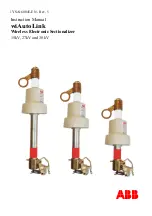
Signal
Description
CB closed
CB position indicator input.
•
F: function disabled
•
T: function enabled
•
xx: all binary inputs (or outputs of protection functions)
VT Superv
supervision input.
•
F: tripping enabled
•
T: tripping disabled
•
xx: all binary inputs (or outputs of protection functions)
Ext Start L1
Ext Start L2
Ext Start L3
Ext Trip 3P
Ext Trip
Inputs for the distance function signals Start L1, Start L2, Start L3, Trip CB 3P and
Trip CB for coordinating operation.
•
F: not connected
•
xx: all binary inputs (or outputs of protection functions)
Trip
Tripping signal.
Start
Output for signaling that the protection has picked up, that is, the current has
exceeded the enabling setting (
I-Setting).
MeasFwd
O/P for signaling a fault in the forwards direction.
MeasBwd
O/P for signaling a fault in the backwards direction.
Send
PLC transmit signal.
5.9.6
Configuration
5.9.6.1
Coordination with the distance protection
GUID-E9376218-990F-48DA-BC17-10D3136FA975 v1
Directional ground fault function as ancillary to the distance function
Compared with a standalone ground fault function, the ground fault function integrated in the
distance function needs certain starting and tripping signals generated by the distance
function and the E/F protection is blocked in the following situations:
•
starting of more than one distance phase
•
three-phase tripping
•
any trip (single and three-phase), if 1 Channel is set to
on
Scheme with independent communication channels
Apart from the added security of redundancy, independent communication channels enable
different transfer tripping schemes to be used for ground fault and distance protections.
Providing the distance protection can detect a fault, it should trip before the ground fault
protection picks up. For this reason, the basic operating time (t
Basic
) for the ground fault
protection must be set longer than the longest response time to be expected of the distance
protection.
Scheme with a common communication channel
Where ground fault and distance protections use the same communication channel, the
transfer tripping schemes must be either both permissive or both blocking. In the case of
permissive schemes, in which the distance protection operates with non-directional criteria at
one end for a weak infeed, a supplementary logic must be enabled by appropriately setting the
parameter 1 Channel.
Section 5
1MRK 505 406-UEN B
Bay protection functions
160
Bay protection functions REB500
Technical manual
© Copyright 2019 ABB. All rights reserved









































